The Obvious Way Funnel Cake Got Its Name
America has produced a lot of great foods — the lobster roll, the Philly cheesesteak, and pretty much any dish that originated in New Orleans are all good examples of tasty, uniquely American culinary creations. But perhaps one of the most fun American adaptations is a food that's less a full meal on its own and more of a delicious snack: funnel cake. The primary province of state and county fairs (where it's one of the less outrageous examples of state fair food), funnel cake is a wonderfully rich dessert that hits on a classic winning food combo: sugar and crispy dough.
But how did funnel cake get its name in the first place? Well, a lot of foods may be named after what they supposedly look like — whether or not they actually look like the thing they're named for — but funnel cake isn't one of them. Instead, funnel cake has its moniker because it is quite literally made by squeezing batter through a funnel into hot oil. There's not a ton of mystery there.
Funnel cake was created by the Pennsylvania Dutch
Funnel cake may be everywhere at state fairs and Renaissance festivals in America now, but like many creative American foods, its predecessors came from Europe. There are medieval cookbooks from Central Europe that make mention of something known as "mincebek" — in all likelihood a mix-up of the term "mise en bec," meaning something like "putting in a beak" or "putting in a spout." These dishes were essentially fritters made by pouring batter through a hole in a bowl into hot oil.
But the modern funnel cake was born much later. In America, they appear to have been created by the descendants of the European immigrants who were known for making mincebek: the confusingly-named Pennsylvania Dutch (who were mainly from German-speaking countries). The Pennsylvania Dutch have an exceedingly long history in America, having settled in what would become the United States starting in 1683 (this is why later-arriving German immigrants are typically known as German-Americans). They've made a lot of contributions to America's culinary legacy, including Pennsylvania Dutch cake, Rivel soup, shoofly pie, and even the meat concoction known as scrapple. Food historians believe funnel cake is among these contributions to American cooking.
Funnel cakes rose to prominence in the 20th century
Indeed, the first recipe for what can be easily recognized as funnel cake comes from an 1879 cookbook written in German. It wasn't until 1935 that it came to be called "funnel cake" in an English-language cookbook — again, named after the apparatus used to drizzle the batter into the oil, thus creating the dish's signature criss-crossing ribbons of fried dough. In the 1950s, funnel cake well and truly took off, becoming a staple of fairs and carnivals thanks to the fact that it was easy to make and even easier to store (it doesn't have a complex list of ingredients, after all).
Funnel cake is now often made with pastry bags as an alternative to funnels, although really, you can make homemade funnel cake with whatever tool works best for you. They're easy to whip up, since you're basically just making a batter that's similar to pancakes — and you don't have to drizzle them with any great skill into your hot oil. Quick and easy, sweet and crispy: It's easy to see why the funnel cake has become a popular part of American culinary culture.


